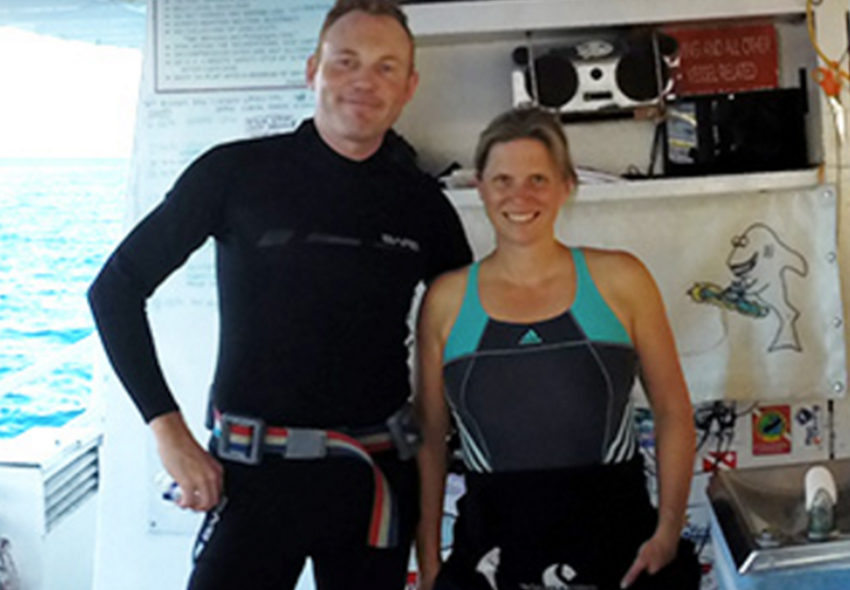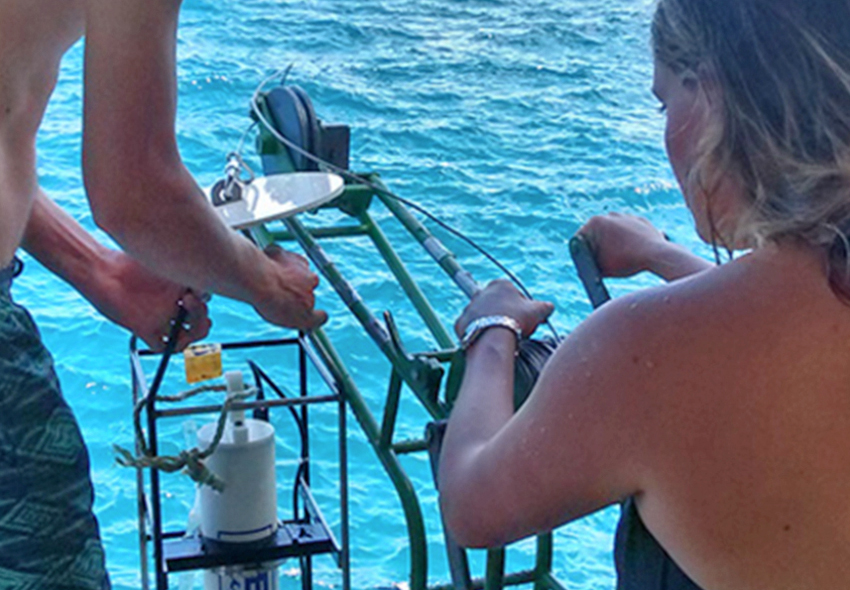Physical physics
Wednesday 28 October 2015, I’m Janine Nauw (photo above: on right of Oscar Bos), physical oceanographer at the Royal NIOZ. In early May, I was invited to join the cruise on the Caribbean Explorer II (CE II) doing the physics part of the CoralCarib project, which looks into the calcification or erosion of the corals on the Saba Bank. The Caribbean Explorer II is not a research vessel, but a liveaboard. For non-divers, a liveaboad is a vessel for divers to take their holiday on. You can spend your whole holiday in the water, only going out when your dive-computer tells you to breath out some nitrogen, before going back in again. Meanwhile, the cook is preparing wonderful meals in the galley and your bed is being made and your room cleaned; it’s like an all-inclusive resort on the water.
Doing research on a vessel like this is very much possible, I can say now after spending a week on the CE II. I was responsible for investigating the physics, or hydrodynamics, in the area surrounding the experimental site. The experiment involved placing a tent on the reef, closing it up and looking at the changing chemistry in the tent. Yes, you read it correctly, fellow scientists with help of the crew put up a decent size tent on the reef at 15 and 20 m below sea level! Putting pins in the reef is not really possible, so the tent was held in place by putting heavy chains and weights on the flaps that in normal circumstances keep the rain out, but in this case keep the water in. As with every tent, it cannot not be completely closed off from the environment, but always some exchange exists, e.g. the tent leaks. To determine the leakage, we measure the salinity inside and outside of the tent; add a certain amount of salt water in the tent and wait until the salinity in the tent is equal again the one outside of the tent. In practice, this involved actually diving down to the tent and adding a highly saline solution into the tent with a 500 ml syringe (or two).
Besides this, we also took an Acoustic Doppler Current Profiler (ADCP) down, which measures the currents and turbulence structure in the entire water column using sound pulses and recording the Doppler shift of the returned signal. This is a measure for the current speed, just as the change in frequency in an approaching or a parting ambulance is a reference for its speed. On the Saba Bank, it was on the hard reef, but near Saba in Ladders Labyrinth we had a sandy bottom, so we dug The ADCP in, keeping only its “head” above the seafloor giving us an extra 20 cm of data near the seafloor.
Besides diving and digging, operating the CTD was also quite strenuous. A CTD measures salinity, temperature and depth throughout the water column by lowering it to the seafloor and hauling it again using a winch. I, a spoiled scientist who has worked only on proper research vessels, am used to the CTD being operated by an electrical powered winch by the crew, while I’m sitting inside watching a computer screen seeing the data coming in. Here, we don’t have that luxury, as there is no electrical powered which. However, we brought a manual one – I and many others of the scientific crew, got plenty exercise from that, especially on one of the three deeper cast that were more than 100 meters deep.
Hence it took quite some physical work, including lots of diving, some digging and exercising on the CTD-winch, to collect a very nice dataset about the physics of the experimental site. Meanwhile, we were being pampered by the crew, just like any other guest on the CE II would. And all of this in one of the most beautiful places in the world.
EXPEDITION SABA BANK II
OCT - NOV 2015

JANINE NAUW
ROYAL NETHERLANDS INSTITUTE OF SEA RESEARCH


